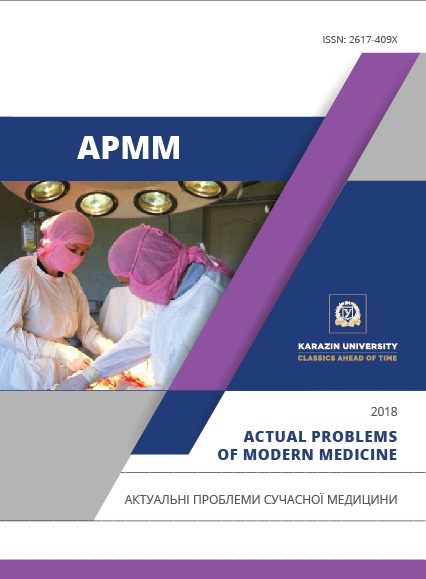ІСТОРИЧНІ, КЛІНІЧНІ ТА ПСИХОЛОГІЧНІ ОСОБЛИВОСТІ ФОРМУВАННЯ ПОСТТРАВМАТИЧНИХ СТРЕСОВИХ РОЗЛАДІВ
Анотація
У статті вивчено історичні аспекти формування поняття про глобальну проблему сучасного суспільства – посттравматичні стресові розлади (ПТСР), розкрито клініко-психологічні особливості їх формування, як у дорослому, так і у дитячому віці. Метою дослідження є аналіз світового досвіду сучасних поглядів на проблему ПТСР, а також вивчення основних механізмів формування даного розладу та наявні факторів ризику захворювання. У роботі було обстежено 2 групи дітей і підлітків 7-18 років: 305 – із сімей вимушених переселенців і 60 осіб контрольної групи, в яку були включені діти зі звичайних сімей. Було проаналізовано основні клініко-психологічні характеристики розвитку ПТСР. За даними літературних джерел ПТСР має досить значну поширеність, як в нашій державі, так і в усьому світі, що актуалізує дану проблему на тлі останніх світових і вітчизняних подій. Особливого значення розвиток цієї психосоматичної патології набуває у дитячому віці з огляду на досить широку різноманітність клінічних проявів й значний психотравмуючий вплив на несформовану дитячу особистість. У роботі було встановлено основні фактори ризику виникнення ПТСР та вплив психотравмуючих чинників на формування особистісно-характерологічних рис особистості.
Завантаження
Посилання
Abramov V. A. (2004)Standards of multi-axis diagnostics in psychiatry, Donetsk, 272 p (in Russian)
Aleksandrov E.O. (2001) Blown up brain. Posttraumatic stress disorder. Clinic and treatment, Novosibirsk: Sibvuzizdat, 154 p (in Russian)
Aleshchenko V.I. (2005) Psychological Rehabilitation of Servicemen with Post-Stress Mental Disorders: Teaching. manual Kharkiv, 84 p (In Ukrainian)
Badina N. P. (2005) Psychological assistance to a child who has experienced a psychological trauma: Method. recommendations for educational psychologists, Kurgan, 5 p (in Russian)
Combat mental injury as a risk factor for the development of chronic post-traumatic stress disorder // Actual problems of psychiatry and neurology: Mater. Vseross Anniversary scientific-practical. conf. with international participation , SPb, Man and health, 2007, P. 38–39 (in Russian)
Bundalo N.L (2004) Neurotic, due to stress, and somatoform disorders. Therapeutic and diagnostic standards: Teaching aid for postgraduate training of doctors Krasnoyarsk, 117 p (in Russian)
Bundalo N. L. Post-traumatic stress disorder in children // Mater. XIV Congress of Psychiatrists, 2005, P. 185
Bundalo N. L. Gender features of manifestations of aggressiveness and hostility in post-traumatic stress disorder // Siberian Medical Review, 2007, № 1, P. 47 -50 (in Russian)
Bundalo N. L. Sexual differences in the clinical manifestations of post-traumatic stress disorder // Modern problems of biological psychiatry and narcology: Mater. second All-Russia. conf. with international participation, Tomsk, 2008, P. 224–225.
Bundalo N. L. Actual issues of the etiology of post-traumatic stress disorder (literature review) // Siberian Medical Review, 2007, № 1, P. 3–10
Bundalo NL. Features of aggression in children with PTSD // Clinical and biological problems of protecting the mental health of motherhood and childhood: Mater. regional scientific-practical. Conf., Tomsk, 2007, P. 29–34
Cardiner A. (2010) Psychological boundaries of society, 231 p
Criteria for diagnostics and principles of psycho-romance of mental health and behavior among children and children (2001) P.V. Voloshin, V.M. Ponomarenko, V.S. Pіdkoritova [et al], Kharkiv, Folio,271 p (In Ukrainian)
Korolchuk M.S. (2006) Social and Psychological Psychology, in General and Extreme Minds, Nika-Center, 580 p (in Russian)
Litvintsev S. V. (2005) Combat mental trauma: a guide for physicians, Medicine, 432 .
Martsenkovsky I. A. Post-traumatic stress disorder in children: the search for a new meaning // Health newspaper of Ukraine, 2007, № 170, P. 16–19
International Classification of Diseases (10th revision) (1999) Classification of mental and behavioral disorders. Clinical description and diagnostic instructions, Yu. L. Nuller, S. Yu. Tsirkina, Fakt, 259 p.
Multi-axis classification of mental disorders in childhood and adolescence Classification of mental and behavioral disorders in children and adolescents in accordance with ICD-10 (2003), SPb, Speech, 407 p
Padun MA. (2012) Mental injury and picture of the world. Theory, empiricism, practice, Institute of Psychology of the Russian Academy of Sciences, 141 p (in Russian)
Pushkarev A.L., Domoratsky V.A., Gordeeva E.G. (2000) Posttraumatic stress disorder: diagnosis, psychopharmacotherapy, psychotherapy, Publishing House of the Institute of Psychotherapy, 128 p (in Russian)
Pyatnitskaya Ye.V. (2007) Psychology of traumatic stress: studies. Manual, Nikolaev, 140 p
Reshetnikov M.M. (2006) Mental Trauma, SPb, East European Institute for the Study of Psychoanalysis, 322 p (in Russian)
Semenyuk L.M. (1996) Psychological features of aggressive behavior of a teenager, Voronezh, 96 p (in Russian)
Sidelnikov S. A. (2013) Peculiarities of post-traumatic stress syndrome in children // Medical Internet Conference Bulletin, Vol. № 2, P. 236
Synopsis of Diagnostic Criteria DSM-V and Protocols of NICE for Diagnostics and Likewise of the Basic Psychic Concepts of Children and Children and People. (2014) H English; ed. L. Pidlіtsetska, Lviv: Vidavnitstvo Ukrainian Ukrainian Catholic University, 112 p (In Ukrainian)
N. Tarabrina (2009) Psychology of Post-Traumatic Stress: Theory and Practice, Institute of Psychology of the Russian Academy of Sciences, 303 p.
Tsikhonya V. Pam’yatka about post-traumatic stress disorder // Art Gallery, 2014, P. 57–58
Bundalo N. L. Clinical model of chronic post-traumatic stress disorder // Ross. Biomedical Journal Medline.ru, 2007, T. 8, P. 694–702
Coil J. D. Aggression and antisocial behavior. In W. Damon, N. Eisenberg. Handbook of child psychology, 1998, P. 779–862
DSM-IV-TR, Diagnostic and mental manual of mental disorders. Edition 4 (text revised) (2000) The American Psychiatric Association, 943 p
Green A. H. Children traumatized by physical abuse // S. Eth, R. S. Pynoos (Eds.). Post-traumatized stress disorders in children, Washington, American Psychiatric Association, 1985, P. 133–154




